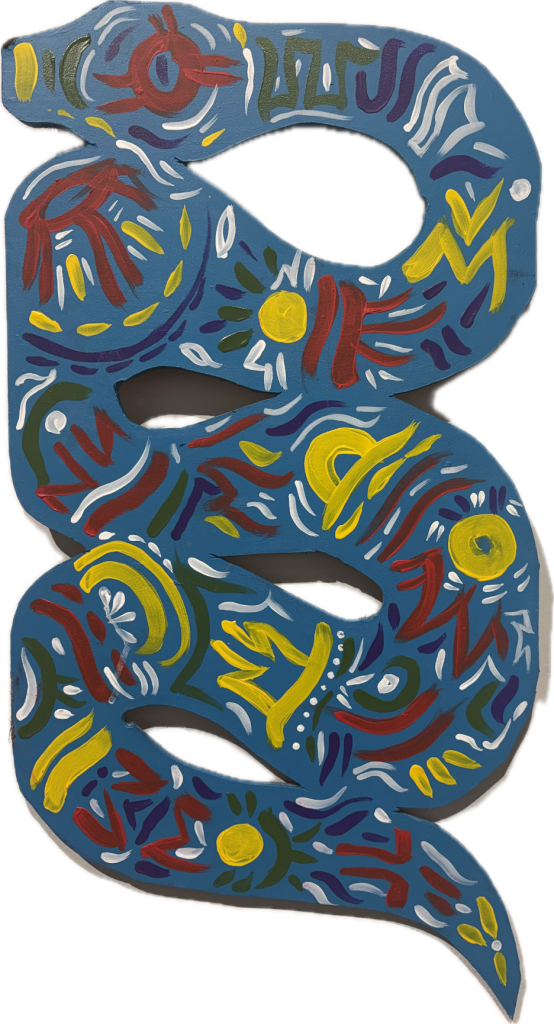by Sammye C. Hamilton
The Dedo Maranville Gallery has once again successfully hosted an artist that offers viewers new insight into art that is both visually appealing and inspires questions on cultural differences between viewer and artist. Chico Sierra does not blatantly specify his cultural background, but many aspects of his work give clues as to who he is as an artist and how his culture has been impacted in the past and how it inspires him as an artist.

Sierra includes specific imagery and Aztec style strokes throughout many of the paintings featured. Two images used repeatedly are the cacti and the snake. The cacti are native to arid climates such as Mexico and parts of the mid-western United States. Chico Sierra is from El Paso, Texas. El Paso was once a part of Mexico and is still heavily influenced by Mexican culture. The cacti appear in Familia Radicale, The Good Sun, Slow Collisions, Sisters of Common Threads, and The Revolution of Inheritance. Each of these works are dynamic and incorporate vibrant colors. The cactus requires very little water or care and it not only survives in the harsh sun and heat, but thrives. To the Aztecs and Mexican cultures, the cactus is a symbol of resilience. The cactus blooms even in harsh environments, and by including it in his artwork, Chico Sierra pays homage to his cultural background, and gives viewers context to the paintings.
The secondary image repeated throughout multiple paintings in the show is the snake. The snake appears in multiple paintings including; Familia Radicale, Sisters of Common Threads, The Revolution of Inheritance and Blue Snake.

The snake has been a significant creature in many cultures and throughout history. Chico Sierra is clearly fond of the Aztec/ Mexican style of artwork, but his art is not limited to this style or cultural subject matter alone. To the Aztecs, the snake was a goddess, representing life and death simultaneously. The significance of the snake in Sierra’s paintings is also simultaneously representative of a plethora of ideas. In the painting, Sisters of Common Threads, Sierra explores the common experiences of women in different cultures, showing how that even though they come from different cultural backgrounds they are bonded over their shared experiences as women. The snake also appears in the painting, The Revolution of Inheritance.

In this painting however, the snake is white and cut into pieces, and within each segment, the snake has a cross symbol. This snake is a symbol of how the white culture has tried to drown out the culture and practices of indigenous people in order to colonize them.
The theme of multiple meanings is common throughout the show. Just like how the snake can have multiple meanings, so can a person. Chico Sierra is proud of his culture and the past, because it has a strong stylistic influence on his artwork, but he also embraces the idea that his own identity and experiences shape him as a person as well as an artist. The painting, The Good Sun, is the perfect combination of past and present self expression. The painting shows the pressure the artist feels to make his parents proud (hints the title of the work). This theme is also expressed through the use of color in the painting and how the more vibrant colors are shown within the person rather than surrounding him. The dual use of the word Sun (Son) also holds significance because the Sun is the center of the solar system and controls the growth and survival of humans and the planet. We rely on the power of the sun for survival and the artist symbolically feels this same pressure to succeed.
The multiplicity of themes and simultaneous significance of symbols and images relate back to the purpose of the artwork to the artist. These ideas show that a person is not limited to one aspect of themselves or their culture. People are three dimensional beings and our backgrounds are a significant portion of who we are but we are not limited to it because we are continuously evolving. Chico Sierra’s artwork is visual representation of this multifaceted concept.